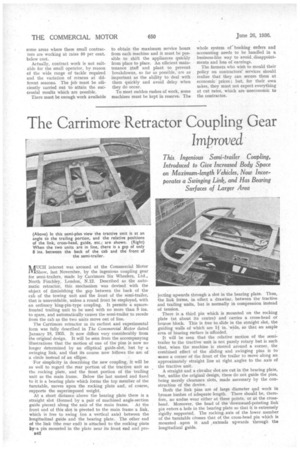The Carrimore Retractor Coupling Gear Improved
Page 84

If you've noticed an error in this article please click here to report it so we can fix it.
This Ingenious Semi-trailer Coupling, Introduced to Give Increased Body Space on Maximum-length Vehicles, Now Incorporates a Swinging Link, and Has Bearing Surfaces of Larger Area
ART.:CFI interest was aroused at the Commercial Motor IVIShow, last November, by the ingenious coupling gear for semi-trailers, made by Carrimore Six Wheelers, Ltd., North Finchley, London, N.12. Described as the automatic retractor, this mechanism was devised with the object of diminishing the gap between the back of the cab of the towing unit and the front of the semi-trailer, that is unavoidable, unless a round front be employed, with an ordinary king-pin-type coupling. It permits a squarefronted trailing unit to be used with no more than 8 ins. to spare, and automatically causes the semi-trailer to recede from the cab as the two units move out of line.
The Carrimore retractor in its earliest and experimental form was fully described in The Commercial Motor dated January 18, 1935. It now differs very considerably from the original design. It will be seen from the accompanying illustrations that the motion of one of the pins is now no longer determined by an elliptical guide-slot, but by a swinging link, and that its course now follows the arc of a circle instead of an ellipse.
For simplicity in describing the new coupling, it will be as well to regard the rear portion of the tractive unit as the rocking plate, and the front portion of the trailing unit as the main frame. Below the last named and fixed to it is a bearing plate which forms the top member of the turntable, moves upon the rocking plate and, of course, supports the superimposed weight.
At a short distance above the bearing plate there is a straight slot (formed by a pair of machined angle-section guide pieces) along the axis of the main frame. At the front end of this slot is pivoted to the main frame a link, • which is free to swing (on a vertical axis) between the longitudinal guide and the bearing plate. The other end of the link (the rear end) is attached to the rocking plate br a pin mounted in the plate near its front end and pro
1342 jecting upwards through a slot in the bearing plate. Thus, the link forms, in effect a drawbar, between the tractive and trailing units, but is normally in compression instead of tension.
There is a third pin which is mounted on the rocking plate (at about its centre) and carries a cross-head or bronze block. This is free to slide in the straight slot, the guiding walls of which are 1+ in. wide, so that an ample area of bearing surface is afforded. • It will be seen that the relative motion of the semitrailer to the tractive unit is not purely rotary but is such that, when the machine is steered around a corner, the combined effect of the sliding and swinging pins is to• cause a corner of the front of the trailer to move along an approximately straight line at right, angles to the axis of the tractive unit.
A straight and a circular slot are cut in the bearing plate, but, unlike the original design, these do not guide the pins, being merely clearance slots, made necessary by the construction of the device.
Both the link pins are of large diameter and work in bronze bushes of adequate length. There should be, there fore, no undue wear either at these points, or at the cross head. Moreover, the head of the 'downward-pointing link pin enters a hole in the bearing plate so that it is extremely
rigidly, supported. The rocking, axis of the lower member of the turntable cfosses that of. the cross-head pin which is mounted • upon it and , extends upwards throtigh the longitudinal guide.












































































































































